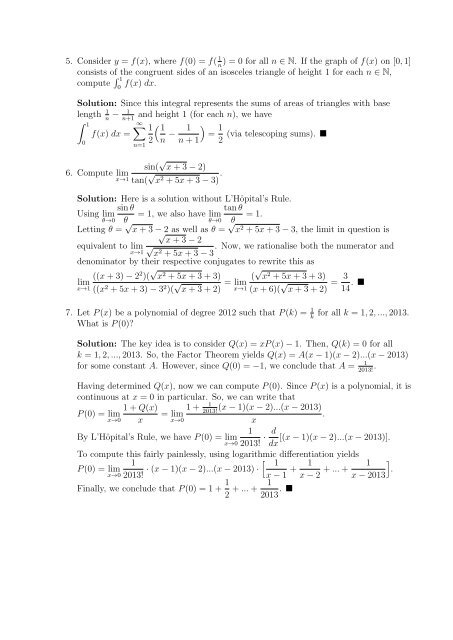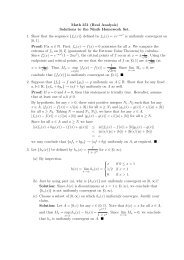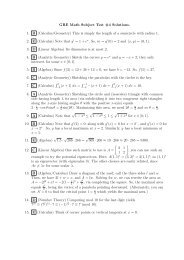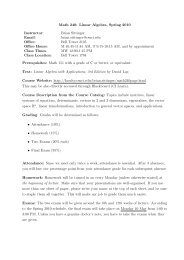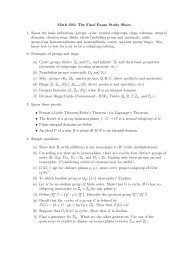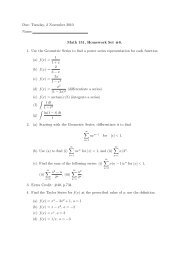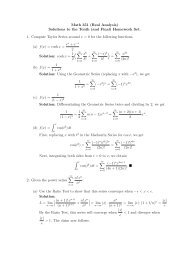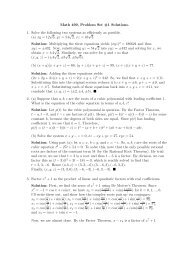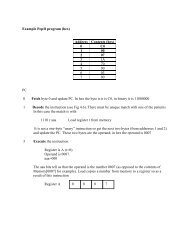Math 499, Problem Set #6 Solutions. 1. Find all solutions to f(x)+2f(1 ...
Math 499, Problem Set #6 Solutions. 1. Find all solutions to f(x)+2f(1 ...
Math 499, Problem Set #6 Solutions. 1. Find all solutions to f(x)+2f(1 ...
Create successful ePaper yourself
Turn your PDF publications into a flip-book with our unique Google optimized e-Paper software.
5. Consider y = f(x), where f(0) = f( 1 ) = 0 for <strong>all</strong> n ∈ N. If the graph of f(x) on [0, 1]<br />
n<br />
consists of the congruent sides of an isosceles triangle of height 1 for each n ∈ N,<br />
compute ∫ 1<br />
f(x) dx.<br />
0<br />
Solution: Since this integral represents the sums of areas of triangles with base<br />
length 1 − 1 and height 1 (for each n), we have<br />
n n+1<br />
∫ 1<br />
∞∑ 1<br />
( 1<br />
f(x) dx =<br />
2 n − 1 )<br />
= 1 (via telescoping sums). <br />
n + 1 2<br />
0<br />
n=1<br />
6. Compute lim<br />
x→1<br />
sin( √ x + 3 − 2)<br />
tan( √ x 2 + 5x + 3 − 3) .<br />
Solution: Here is a solution without L’Hôpital’s Rule.<br />
sin θ<br />
tan θ<br />
Using lim = 1, we also have lim = <strong>1.</strong><br />
θ→0 θ<br />
θ→0 θ<br />
Letting θ = √ x + 3 − 2 as well as θ = √ √ x 2 + 5x + 3 − 3, the limit in question is<br />
x + 3 − 2<br />
equivalent <strong>to</strong> lim √ . Now, we rationalise both the numera<strong>to</strong>r and<br />
x→1 x2 + 5x + 3 − 3<br />
denomina<strong>to</strong>r by their respective conjugates <strong>to</strong> rewrite this as<br />
((x + 3) − 2 2 )( √ x<br />
lim<br />
2 + 5x + 3 + 3)<br />
x→1 ((x 2 + 5x + 3) − 3 2 )( √ x + 3 + 2) = lim ( √ x 2 + 5x + 3 + 3)<br />
x→1 (x + 6)( √ x + 3 + 2) = 3<br />
14 . <br />
7. Let P (x) be a polynomial of degree 2012 such that P (k) = 1 k<br />
What is P (0)<br />
for <strong>all</strong> k = 1, 2, ..., 2013.<br />
Solution: The key idea is <strong>to</strong> consider Q(x) = xP (x) − <strong>1.</strong> Then, Q(k) = 0 for <strong>all</strong><br />
k = 1, 2, ..., 2013. So, the Fac<strong>to</strong>r Theorem yields Q(x) = A(x − 1)(x − 2)...(x − 2013)<br />
for some constant A. However, since Q(0) = −1, we conclude that A = 1<br />
2013! .<br />
Having determined Q(x), now we can compute P (0). Since P (x) is a polynomial, it is<br />
continuous at x = 0 in particular. So, we can write that<br />
1 + Q(x) 1 + 1 (x − 1)(x − 2)...(x − 2013)<br />
2013!<br />
P (0) = lim = lim<br />
.<br />
x→0 x x→0 x<br />
1<br />
By L’Hôpital’s Rule, we have P (0) = lim<br />
x→0 2013! · d<br />
[(x − 1)(x − 2)...(x − 2013)].<br />
dx<br />
To compute this fairly painlessly, using logarithmic differentiation yields<br />
1<br />
[<br />
P (0) = lim<br />
x→0 2013! · (x − 1)(x − 2)...(x − 2013) · 1<br />
x − 1 + 1<br />
x − 2 + ... + 1<br />
]<br />
.<br />
x − 2013<br />
Fin<strong>all</strong>y, we conclude that P (0) = 1 + 1 2 + ... + 1<br />
2013 .


